Many design teams are caught in the crossroads between user needs and client requirements during product design—the failure to fit into the sweet spot between the two impacts both quality & designer credibility. Exclusively suiting client needs in your design can result in a product that is simply cost-centric; an effective design aims to improve the target user experience as well.
This blog will supply you with some key recommendations to find the balance between the client and user needs to create a winning product design.
Recommendation 1: Involving the Client and the User
Conventional software design wisdom dictates that you can’t cater to every stakeholder during the design process. However, it can be extremely beneficial to involve them in the beginning stages.
Here’s why stakeholders need to participate in the design actively:
- The client/user has first-hand knowledge about the expected product performance, as they represent the single-point-of-contact for domain expertise. Their input is precious during the early portion.
- Actively involving clients and users in the design process quickly captures realistic ideas and addresses practical problems.
The best ways for client-user-designer collaboration are:
Workshops & Joint Research
Workshops held during discovery, planning, design/redesign, implementation, and post-implementation of a software design helps designers:
- Discuss concerns and ideas carefully while analyzing clients’ past/present experiences relating to the product features.
- Perform joint research on the different design aspects affecting customer experience and UX based on the data in-hand.
- Discuss the probabilities and possibilities of certain events.
- Save a lot of time & effort spent in corrections and design revisits.
- Plan agendas for new product design or enhancement/bug fixing of existing products.
- Gather people with different perspectives and goals to throw light on some of the hidden concepts/issues/topics that might not appear in individual interviews.
Suggested techniques: Branding cards, stakeholders map, MOSCOW technique.
Knowledge Sharing
Clients and users can collaborate with the designer to share their best and worst experiences.
- The client’s knowledge can draw information about the target group, typical user paths, pain points, or other things that will add value at a later stage of the project.
- Similarly, functionality-wise, users can help the designer enhance the design and apply better techniques by sharing timely information.
- Working together on a persona, a customer journey, or just mapping the most common user paths lets you design a product that addresses the target group’s problems.
Suggested techniques: Personas, scenario mapping, empathy map, Customer Journey Map, user stories, etc.
Recommendation 2: Prioritization Matrix
Weighing the cost against value and efforts against time can be challenging when designers need to cater to multiple users/clients.
A Prioritization Matrix offers clarity and determines value based on the execution time when lining up the task by organizing all user and client needs into four well-defined categories:
- High Impact & High Urgency
- High Impact & Low Urgency
- Low Impact & High Urgency
- Low Impact & Low Urgency
Designers can focus on immediate requirements to reap the most value with lesser risks. The scope ranges from simple design-driven tasks and complex design issues to requests from single-user/client and collective groups or organizations.
Four Common Types of Prioritization Matrices
| Prioritization Matrix Name |
Description | Example |
| Eisenhower’s | Divide tasks based on importance & urgency |
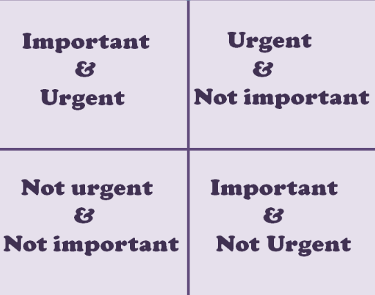 |
| Value and Effort | This matrix divides the group of tasks based on task-related efforts and their value to the user/client. |
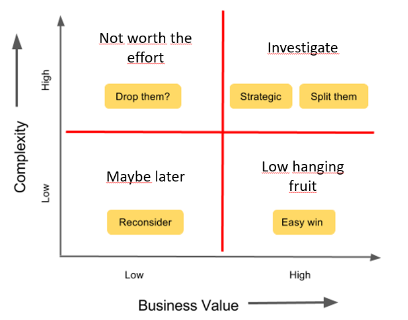 |
| Value and Risk | With this type, designers can divide tasks into four categories based on workflow value and the real risk of a particular activity. Risk scoring is done based on these three criteria: Schedule risk – The risk determined by the time the task starts. Cost risk – The risk is based on rather expensive and irrelevant task execution. Functionality risk– The risk affects technological possibility to do the task. |
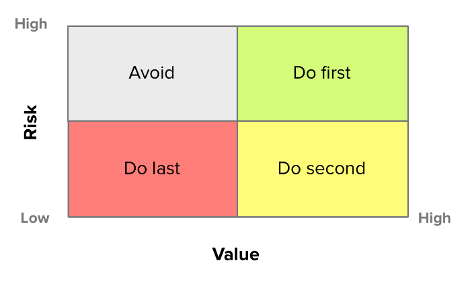 |
| Value and Complexity | Based on direct business value and complexity, the designer can represent the low level with tasks holding minimum priority & complexity, and the highest level with a more complicated degree of execution that offers maximum business value. |
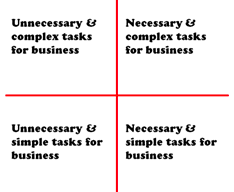 |
Recommendation 3: Setting a Minimum Viable Product (MVP)
An MVP is the first usable version of a product that follows a lean concept. It defines what to expect during your first round of designing and iteration; nothing more, nothing less.
Setting expectations during each iteration helps designers avoid conflicts and work in tandem with the approved design steps.
An MVP is different from a prototype. Here’s how.
Why Designers need an MVP?
According to CB Insights, 42% of companies fail because there was no market need for the product designed/developed.
With an MVP or Minimum Viable Product, project goals and tasks can be reasonably set.
Here are other reasons why agile environments need an MVP:
| Need | Description |
| Build the Core of Your Product |
The focus lies on building the core product version that meets business viability parameters. |
| Enables Market Validation | Designers can understand if the users will accept the product, what makes it unique, and gather feedback to make the product viable. |
| Reduces Rework | Building extended features for an unreleased product is time-consuming. Incremental feedback helps zero-in on the reusable components of the working product needing minimal rework. |
| Enables Faster Release | A ready and functional product can be pre-launched or quickly released to increase the customer base early on. This will help you distinguish between the early adopters, late adopters, and laggards. 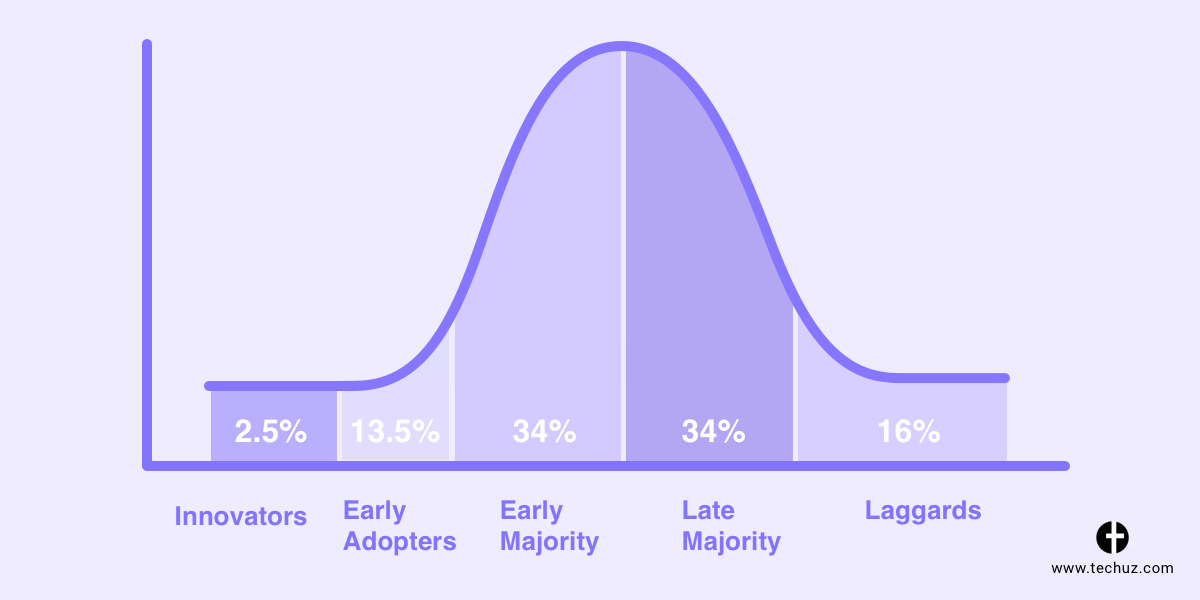 |
| Validates Business Functions | Business functions like sales, marketing and business model assumptions can be evaluated in advance. |

An MVP allows designers to gain the maximum amount of validated learning with the least amount of effort. Based on the information gained from this experiment, the team continues, modifies, or cancels work on the product.
Designers can fail by making common mistakes while developing an MVP.
Here’s an example of the wrong and right ways:

An ideal MVP should deliver a minimum yet viable & valuable product design, and it must:
- Be useful to at least one specific audience.
- Address at least one fundamental problem.
- Have a well-designed UX.
- Be easy to build and launch quickly.

Having helped multiple companies with our expertise, Radiant Digital can help you build a viable MVP faster and cost-efficiently. Our goals are focused on:
- Testing a product’s design viability at low costs.
- Spending less money on product design & development.
- Faster delivery of a product that solves at least one significant problem of a user.
We implement proven concepts to establish user-client requirement balance, address the pain points, and help your product deliver the best customer experience.
Here’s a step-by-step guide to planning an MVP. It would be best if you approached an expert to build an MVP efficiently.
Want this for your business? Talk to us. We’ll help you get there. Contact us.
Recommendation 4 – Usability Heuristics
It’s not worth designing a good-looking product that cannot derive ROI in a competition-driven market. Heuristics are broad rules of thumb for UI design that give designers a peek into how their design works.
The Heuristic Evaluation Method, introduced by Jakob Nielsen, helps compare a digital product’s compliance with a set of established usability principles (Heuristics) for human-computer interaction.
Advocating for usability can help calm tough situations, and speaking to clients and users on the heuristics of usability display your credibility as a UX Designer.
Usability Heuristics Help:
- Identify common usability issues with a product and resolve them earlier.
- Improve user satisfaction and experience with empirical rules of thumb, best practices, conventions, standards, and observation rules.
- Increase the chance of a product’s overall success.
This usability inspection method is usually performed by 5 to 8 evaluators who have expertise in product-relevant heuristics, interaction design, human-computer interaction, and/or UX design, among other subjects.
Usability Heuristics Analysis Process
- Individual evaluators assign a “severity rating” to each of the usability issues identified.
- As a rule, UX designers work their way down from the most critical issues on the backlog to the least critical ones.
- The design team typically gives issues with the highest severity rating the most attention.
What does ‘Usability’ entail?
Quality components like,
- Learnability
- Discoverability
- User Satisfaction
- Flexibility
- Memorability
- Error handling
When to do it?
| New Products | Existing Products |
| Usually, later in the design phase after wire-framing and prototyping, and before visual design and UI development begins. |
Usually, before redesigning begins. |
Usability Heuristics Report
Though a Usability Heuristics Report for each product may look different, a specimen is shown below.
-

Image Source: Team 6_Design -
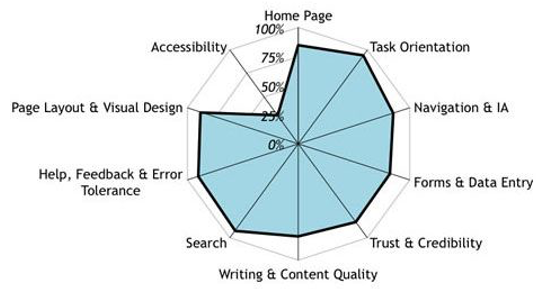
Image Source: Pintrest

Designers need to understand usability heuristics well to apply them relevantly in the design process.
Conclusion
We hope that the four recommendations made in this article will help you bridge the gap between user and client needs to resolve inconsistencies, ensure you’re all on the same page, and develop a high-performing product design.
To learn how Radiant Digital strategizes and implements proven guidelines for Exceptional Web Design, Usability, and User Experience to your products, call us today!
